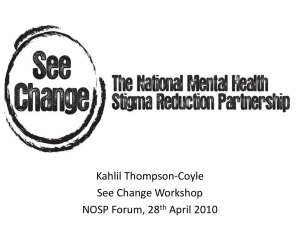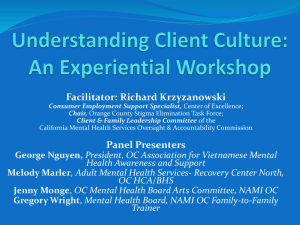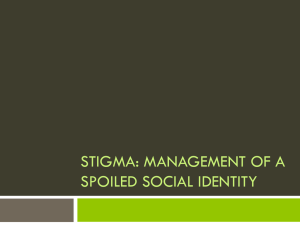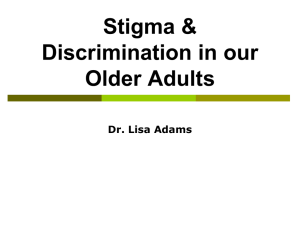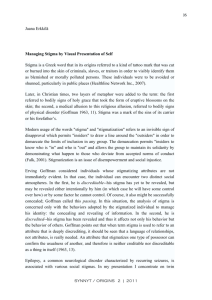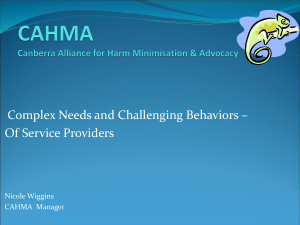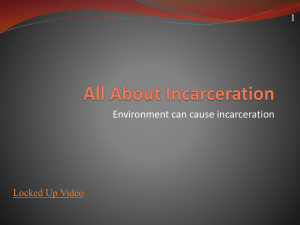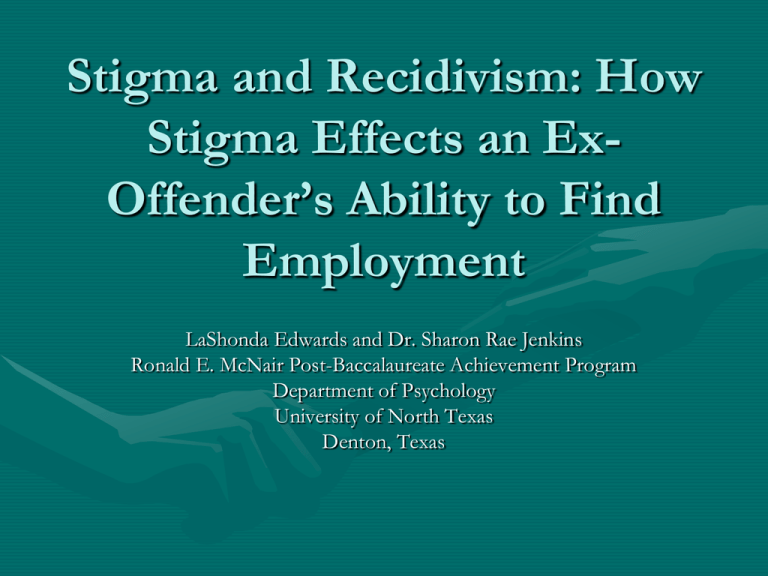
Stigma and Recidivism: How
Stigma Effects an ExOffender’s Ability to Find
Employment
LaShonda Edwards and Dr. Sharon Rae Jenkins
Ronald E. McNair Post-Baccalaureate Achievement Program
Department of Psychology
University of North Texas
Denton, Texas
Introduction
• Little empirical attention has been given to if, how, and
why stigma impacts the lives of former prisoners.
• While the proliferation of self-help organizations and
literature suggests that many of us believe that we can
change our own lives, personalities, or behaviors, we do
not necessarily extend this belief in the potential to
change to others
• This study will investigate the affect stigma has on
released prisoners success in obtaining employment.
Recidivism
• For the purposes of this study,
recidivism is defined as a relapse
into criminal behavior that results
in incarceration.
• Reentry Trends in the U.S.
• In a 15 State study, over two-thirds
of released prisoners were
rearrested within three years.
– Bureau of Justice Statistics
Statistics and Race
More than 6 in 10 persons in local
jails in 2002 were racial or ethnic
minorities, unchanged from 1996
(Bureau of Justice Statistics).
• Blacks and Hispanics together
account for about two-thirds of the
state prison population.
• Black men are six to eight times
more likely to be in prison than
whites.
• If white men were incarcerated at
the same rate as blacks there would
be over 6 million people in prison
and jail (Western, 2007).
•
Stigma
• Social stigma has its roots in the early work of Erving
Goffman’s classic book Stigma: Notes on the Management
of a Spoiled Identity.
• According to Goffman (1963, p. 3) stigma is an
attribute that extensively discredits an individual,
reducing him or her “from a whole and usual person to
a tainted discounted one”.
• Goffman (1963, p.5) stated that “by definition, of
course, we believe the person with a stigma is not quite
human”.
Consequences of Stigma
• “It is generally understood that members of
stigmatized groups are devalued and discredited
and often suffer from social exclusion as a
result” (LeBel 2006).
• By limiting access to important life domains,
discrimination directly affects the social status,
psychological well-being, and physical health of
the stigmatized (Major & O’Brien 2005).
Stigma vs. Hiring Desirability
• Stigma can effect the hiring desirability of an exoffender.
– This effect will be studied
• Hiring desirability is operationally defined as the
social appeal of characteristics that are used
when deciding whether to hire a person or not.
– Characteristics such as sophistication, dedication,
intelligence, eagerness etc.
Employment
• One of the key factors to
reducing recidivism is to help
incarcerated felons obtain
steady employment after
their release.
• Not only does incarceration
reduce pay and employment
it reduces the kind of jobs
that are available to formerly
incarcerated workers.
– Career jobs requiring a high
level of trust, skill, credentials,
or well placed social
connections are largely out of
reach for those with prison
records (Western, 2007).
Purpose of Study
• This study will investigate the hiring practices of
employers regarding ex-offenders.
• This study will add to the existing research
literature on this population.
– There is very little research done in this field.
– Previous research has failed to go deeper and find
the specific reasons why ex-offenders can’t find
adequate employment.
Hypothesis
• The top reason that employers will not hire exoffenders is if they were convicted of a violent
crime as opposed to a non-violent crime.
• Higher levels of education may also increase the
chances of being offered a job.
Previous Research
• Giguere and Dundes first attempted to uncover the
specific reasons ex-convicts are not hired by devising a
hypothetical scenario. Respondents were asked whether
their answers would change if sex, length of
incarceration, etc. were different.
– Employers’ greatest hiring concern was that exoffenders may not have the necessary people skills
for contact with customers. The other factors they
found eliciting greatest employer apprehension
concerned customers’ feeling uncomfortable if they
knew than an ex-convict worked at their business
(81%) and worries about coworkers’ discomfort in
working with an ex-convict (77%).
Measure
• A survey will be delivered to non-franchise business in the
Dallas/Fort Worth Metroplex. The survey will consist of eight
questions in the form of a hypothetical scenario that will cover
employers’ hiring practices regarding ex-offenders.
– Type of crime committed (violent or nonviolent), amount
of time served, previous work history, and education
received (before incarceration and after incarceration).
• The survey will also include a likert scale after every scenario
where employers will be asked what factors are most
important and least important in hiring that particular exoffender.
Hypothetical Scenario
• Bonquiesha, female, 32, African American, comes to
your place of employment and applies for a job. She
seems eager to work. She is dressed appropriately but
has on heavy make-up. Before being incarcerated, she
received her B.A. She has five years of previous work
history. While she was incarcerated, she received a
master’s degree. She was incarcerated for 5 years for
assault with a deadly weapon, a violent crime, and was
released six months ago.
• Would you hire this person?
Procedure
• Contact by e-mail or phone will be established
for permission to participate in this study prior
to delivering the surveys.
• Informed notice
• Three forms of the survey
– Reduce primacy and recency effects
– Scenarios presented in random order
Acknowledgments
•
•
•
•
•
Dr. Jenkins
Dr. Ruggero
Dr. Clark
McNair
Deshun
Selected References
• Harrison, B., & Schehr, R. C. (2004). Offenders and
post-release jobs: Variables influencing success and
failure. Journal of Offender Rehabilitation, 39 (3), 3568.
• Goffman, E. (1963). Stigma: Notes on the management of
spoiled identity. New York: Simon and Schuster.
• Giguere, R. & Dundes, L. (2002, December). Help
wanted: A survey of employer concerns about
hiring ex-convicts. Criminal Justice Policy Review 13(4),
396-408.



